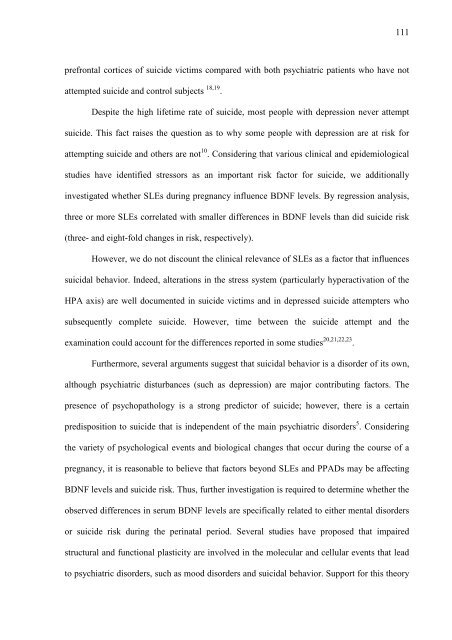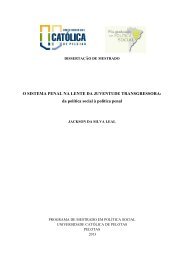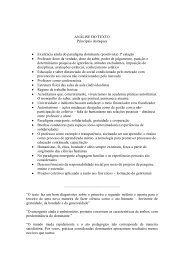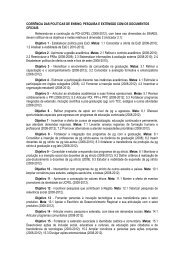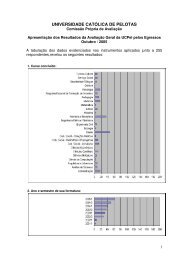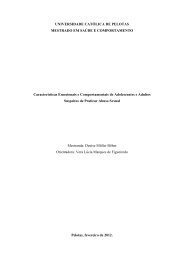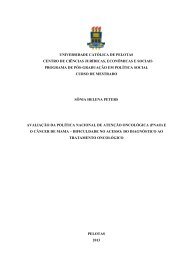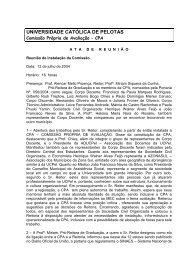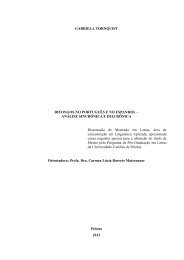Karen Amaral Tavares Pinheiro - Universidade Católica de Pelotas
Karen Amaral Tavares Pinheiro - Universidade Católica de Pelotas
Karen Amaral Tavares Pinheiro - Universidade Católica de Pelotas
Create successful ePaper yourself
Turn your PDF publications into a flip-book with our unique Google optimized e-Paper software.
111<br />
prefrontal cortices of suici<strong>de</strong> victims compared with both psychiatric patients who have not<br />
attempted suici<strong>de</strong> and control subjects 18,19 .<br />
Despite the high lifetime rate of suici<strong>de</strong>, most people with <strong>de</strong>pression never attempt<br />
suici<strong>de</strong>. This fact raises the question as to why some people with <strong>de</strong>pression are at risk for<br />
attempting suici<strong>de</strong> and others are not 10 . Consi<strong>de</strong>ring that various clinical and epi<strong>de</strong>miological<br />
studies have i<strong>de</strong>ntified stressors as an important risk factor for suici<strong>de</strong>, we additionally<br />
investigated whether SLEs during pregnancy influence BDNF levels. By regression analysis,<br />
three or more SLEs correlated with smaller differences in BDNF levels than did suici<strong>de</strong> risk<br />
(three- and eight-fold changes in risk, respectively).<br />
However, we do not discount the clinical relevance of SLEs as a factor that influences<br />
suicidal behavior. In<strong>de</strong>ed, alterations in the stress system (particularly hyperactivation of the<br />
HPA axis) are well documented in suici<strong>de</strong> victims and in <strong>de</strong>pressed suici<strong>de</strong> attempters who<br />
subsequently complete suici<strong>de</strong>. However, time between the suici<strong>de</strong> attempt and the<br />
examination could account for the differences reported in some studies 20,21,22,23 .<br />
Furthermore, several arguments suggest that suicidal behavior is a disor<strong>de</strong>r of its own,<br />
although psychiatric disturbances (such as <strong>de</strong>pression) are major contributing factors. The<br />
presence of psychopathology is a strong predictor of suici<strong>de</strong>; however, there is a certain<br />
predisposition to suici<strong>de</strong> that is in<strong>de</strong>pen<strong>de</strong>nt of the main psychiatric disor<strong>de</strong>rs 5 . Consi<strong>de</strong>ring<br />
the variety of psychological events and biological changes that occur during the course of a<br />
pregnancy, it is reasonable to believe that factors beyond SLEs and PPADs may be affecting<br />
BDNF levels and suici<strong>de</strong> risk. Thus, further investigation is required to <strong>de</strong>termine whether the<br />
observed differences in serum BDNF levels are specifically related to either mental disor<strong>de</strong>rs<br />
or suici<strong>de</strong> risk during the perinatal period. Several studies have proposed that impaired<br />
structural and functional plasticity are involved in the molecular and cellular events that lead<br />
to psychiatric disor<strong>de</strong>rs, such as mood disor<strong>de</strong>rs and suicidal behavior. Support for this theory


